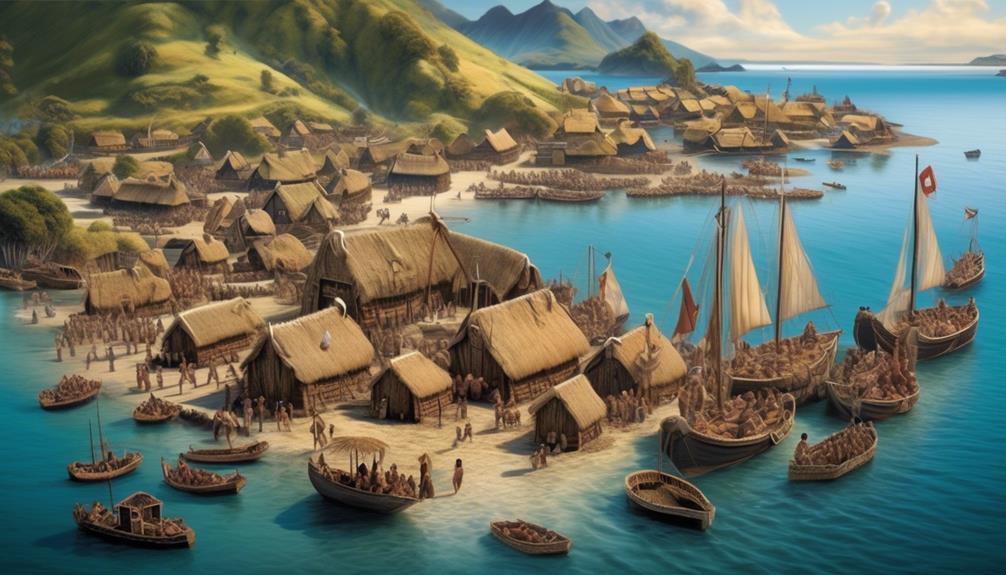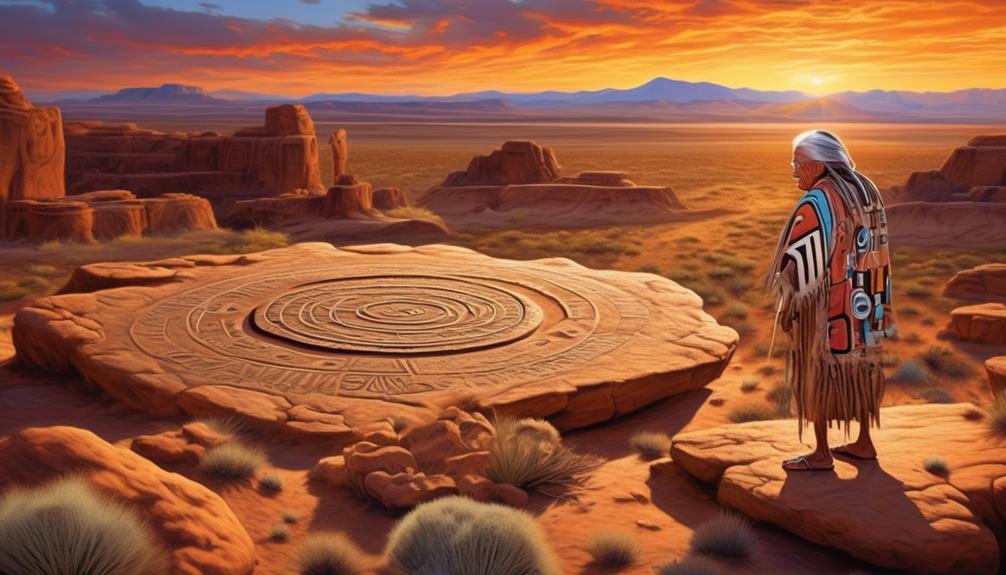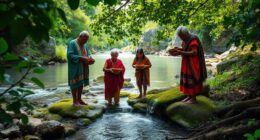The devil is in the details when it comes to understanding the decline of the indigenous Maori population in New Zealand after the arrival of Europeans. The complexities of historical factors are vital.
It's a well-known fact that the Maori population experienced a significant decline, but what are the specific reasons behind this phenomenon?
We'll explore the impact of European diseases, loss of land and resources, social disruption and integration, effects of colonization, and the decline of traditional Maori practices to uncover the complexities of this pivotal period in New Zealand's history.
Key Takeaways
- The introduction of European diseases caused a significant reduction in the Maori population, as they had little to no immunity to these diseases.
- European settlers acquired Maori land through dubious deals and coercive tactics, leading to the loss of physical land and disruption of spiritual and cultural connections.
- The arrival of Europeans disrupted traditional Maori social structures and customs, leading to struggles for social cohesion and cultural assimilation.
- The imposition of European culture, language, and religion, along with the erosion of traditional Maori practices and beliefs, led to the decline of traditional Maori practices.
Impact of European Diseases
The introduction of European diseases to New Zealand had a devastating impact on the Maori population, leading to a significant decline in their numbers. When the European explorers and traders arrived in New Zealand, they inadvertently brought with them diseases such as influenza, measles, and tuberculosis, to which the Maori had little to no immunity. The impact of these diseases was profound, causing a significant reduction in the Maori population.
This was exacerbated by the impact of trade and cultural exchange, where the Maori were introduced to new goods and resources but also to diseases that had a catastrophic effect on their well-being. In the face of these challenges, the Maori demonstrated resilience and adaptation to the European arrival. They attempted to resist the spread of diseases through various means, including quarantine measures and traditional healing practices. However, due to the lack of immunity and the overwhelming nature of the diseases, their efforts were largely ineffective.
Despite their best efforts to adapt to this new health landscape, the introduction of European diseases had a profound and lasting impact on the Maori population in New Zealand.
Loss of Land and Resources
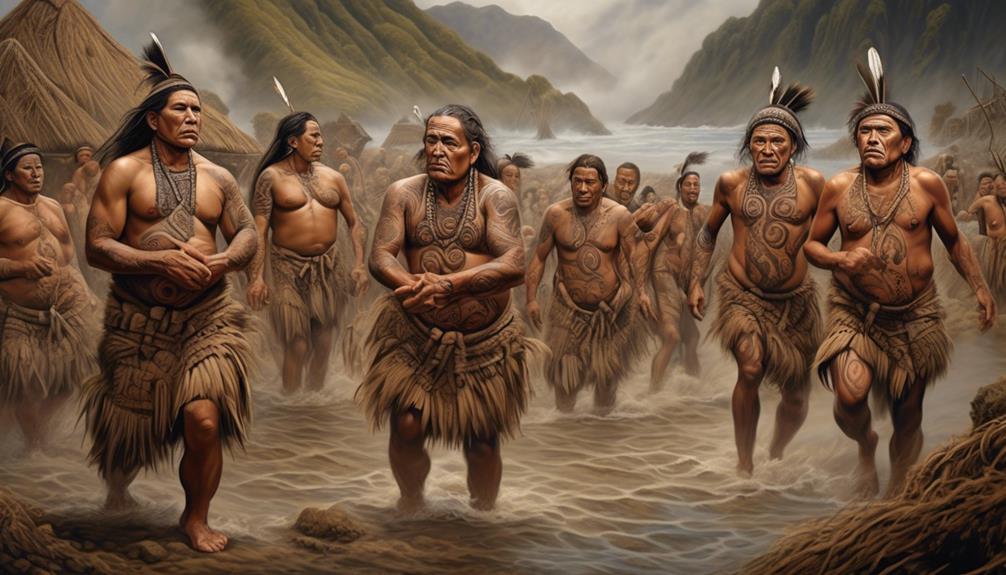
The loss of land and resources significantly impacted the Maori population in New Zealand, leading to socioeconomic upheaval and cultural displacement. This process was driven by several factors:
- Land Dispossession: The arrival of European settlers led to the widespread acquisition of Maori land through dubious land deals, coercive tactics, and the imposition of unfamiliar land tenure systems. This resulted in the loss of not only physical land but also the disruption of spiritual and cultural connections to their ancestral territories.
- Resource Exploitation: The European settlers exploited natural resources vital to the Maori way of life. Forests were cleared, fisheries depleted, and agricultural lands taken over, diminishing the Maori ability to sustain their traditional livelihoods.
- Economic Marginalization: The loss of land and resources precipitated economic hardship for the Maori, who were traditionally reliant on these for sustenance and trade. This led to a significant decline in their economic independence and social standing.
- Cultural Displacement: The loss of land and resources resulted in a profound cultural dislocation, as the Maori were forcibly distanced from their customary practices, leading to a loss of identity and societal cohesion.
These intersecting factors contributed to the profound impact of land dispossession and resource exploitation on the Maori population, perpetuating a cycle of socioeconomic disadvantage and cultural erosion.
Social Disruption and Integration
Experiencing significant social upheaval, the Maori population in New Zealand grappled with the complexities of integration amidst profound cultural and economic challenges. The arrival of Europeans brought about a disruption in the traditional Maori social structures and customs, leading to a struggle for social cohesion and cultural assimilation. The imposition of European systems of governance and land ownership, along with the introduction of new technologies and economic practices, significantly impacted the existing Maori social order.
The disruption caused by the Europeans' arrival led to a breakdown in traditional Maori social structures, resulting in a struggle for social cohesion within the community. The imposition of European systems of governance and land ownership challenged the traditional Maori leadership and societal organization, leading to social fragmentation and internal conflicts.
Furthermore, the process of cultural assimilation, wherein the Maori were pressured to adopt European customs, language, and beliefs, further strained the social fabric of the Maori population. The clash between traditional Maori values and the pressures to conform to European societal norms created internal tensions and hindered the community's ability to integrate effectively.
In essence, the profound social disruption caused by the arrival of Europeans in New Zealand greatly impacted the Maori population, leading to significant challenges in achieving social cohesion and cultural assimilation amidst the complexities of integration.
Effects of Colonization
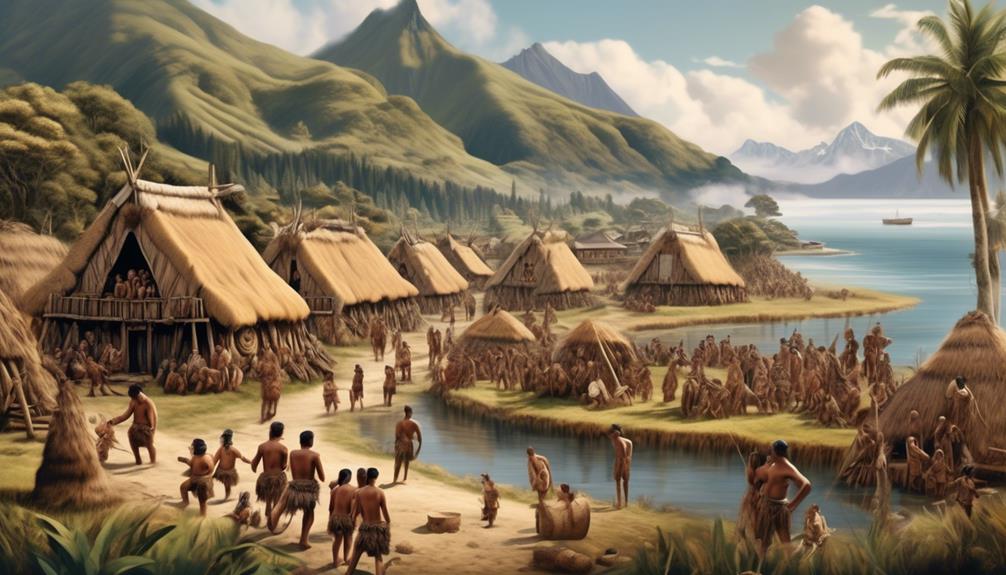
Upon the arrival of Europeans, profound changes were wrought upon the Maori population in New Zealand, profoundly altering their social structures and traditional way of life. The effects of colonization on the Maori population were multifaceted and contributed to their decline in several ways:
- Cultural Assimilation: The imposition of European culture, language, and religion led to the erosion of traditional Maori practices and beliefs. This cultural assimilation disrupted the social cohesion and identity of the Maori community, leading to a loss of cultural heritage and traditional knowledge.
- Economic Exploitation: The introduction of European economic systems and land ownership practices resulted in the dispossession of Maori lands and resources. This economic exploitation deprived the Maori population of their traditional means of sustenance and self-sufficiency, leading to poverty and socioeconomic disparities.
- Displacement and Dispossession: The colonization process led to the displacement of Maori communities from their ancestral lands, disrupting their established social structures and connection to the environment.
- Introduction of Diseases: The arrival of Europeans brought new diseases, such as influenza and measles, for which the Maori had little immunity. This resulted in devastating losses to the Maori population, further contributing to their decline.
These factors collectively contributed to the significant decline of the indigenous Maori population in New Zealand following European colonization.
Decline of Traditional Maori Practices
As we consider the effects of colonization on the Maori population in New Zealand, it becomes evident that the decline of traditional Maori practices is intricately linked to the profound changes wrought upon their social structures and way of life by European arrival.
The process of cultural assimilation, driven by the imposition of European lifestyles and values, played a pivotal role in the erosion of traditional Maori practices. With the arrival of European settlers, the Maori way of life underwent significant transformations. The introduction of new technologies, trade practices, and Western education led to changing lifestyles among the Maori population.
The impact of colonization disrupted the intergenerational transmission of traditional knowledge and practices. The Maori people were compelled to adapt to European customs and societal norms, which gradually supplanted their traditional practices. Moreover, the imposition of European legal and administrative systems further marginalized traditional Maori governance structures and decision-making processes.
Consequently, these factors contributed to the decline of traditional Maori practices as the indigenous population grappled with the challenges of integrating into a rapidly changing socio-cultural landscape.
Frequently Asked Questions
What Efforts Have Been Made to Address the Decline of the Maori Population Since European Arrival in New Zealand?
Efforts to address the Maori population decline since European arrival in New Zealand have included reconciliation initiatives and reparations for historical injustices. These efforts have aimed to rectify the impact of colonization on the indigenous population.
Various policies and programs have been implemented to support Maori communities and address disparities in health, education, and socioeconomic status. These endeavors reflect a commitment to acknowledging and rectifying the historical injustices faced by the Maori people.
How Has the Cultural Identity of the Maori People Been Affected by the Decline in Population?
Cultural preservation is vital for the Maori people. The decline in population has profoundly impacted our cultural identity. We've witnessed traditions fading and language struggling. It's a struggle to maintain our cultural practices and beliefs with fewer people.
The decline has spurred concerted efforts to revitalize Maori culture. We've sought to strengthen our traditions, language, and customs, ensuring our heritage endures for future generations.
What Role Did the Introduction of European Technology and Weapons Play in the Decline of the Maori Population?
The introduction of European technology and weapons had a significant impact on the decline of the Maori population. Firearms from European trade empowered European settlers and disadvantaged Maori resistance. This led to conflicts, contributing to the decline.
The imbalance in weaponry altered power dynamics, affecting the ability of Maori to protect their lands and maintain their cultural preservation and indigenous rights.
How Has the Decline of the Maori Population Impacted the Political and Social Dynamics of New Zealand?
The decline of the Maori population has had significant impacts on the political and social dynamics of New Zealand.
In terms of political representation, the decrease in Maori numbers has influenced the development of specific policies and initiatives to address their underrepresentation.
Moreover, the decline has exacerbated social inequality, leading to disparities in access to resources and opportunities.
These effects have shaped the country's political landscape and social fabric in profound ways.
Are There Any Ongoing Initiatives to Preserve and Revitalize Traditional Maori Practices and Knowledge in Light of the Population Decline?
In the wake of the Maori population decline, preserving traditions and revitalizing Indigenous knowledge have become crucial. Initiatives such as language revitalization programs, land repatriation efforts, and cultural education in schools aim to safeguard and promote Maori customs.
Conclusion
In conclusion, the decline of the indigenous Maori population in New Zealand after the arrival of Europeans can be attributed to a combination of factors.
One major factor was the impact of European diseases. The Maori had no immunity to diseases such as smallpox and influenza, which were introduced by the Europeans. These diseases spread rapidly throughout the Maori population, leading to high death rates and a significant decline in population numbers.
Another factor was the loss of land and resources. As European settlers arrived in New Zealand, they began to acquire Maori land through various means, including treaties and force. This resulted in the displacement of Maori communities and a loss of access to traditional resources, such as forests and fisheries, which had been vital for their survival.
Social disruption and integration also played a role in the decline of the Maori population. The arrival of Europeans brought significant changes to Maori society, including new technologies, customs, and ways of life. This led to social upheaval and disintegration of traditional Maori practices and structures.
The effects of colonization cannot be overlooked either. The imposition of European systems of governance and law had a profound impact on Maori communities. This often resulted in the marginalization and exclusion of the Maori people from political and economic power, further contributing to their decline.
Lastly, the decline of traditional Maori practices played a part in the population decline. As the Maori population was exposed to European ways of life, some aspects of their own culture and traditions began to erode. This included practices related to health and well-being, which may have made them more susceptible to the diseases introduced by the Europeans.
While some theories suggest intentional harm by Europeans, evidence points more towards unintended consequences of their arrival and interactions with the Maori population. It is important to recognize the complex interplay of these factors in order to understand the decline of the indigenous Maori population in New Zealand.
